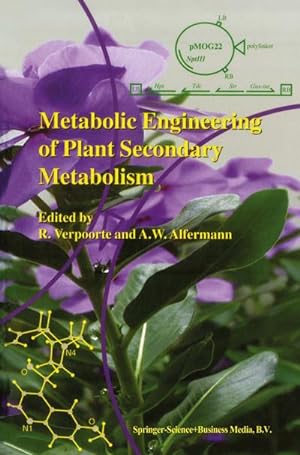9780792363606 - Metabolic Engineering of Plant Secondary Metabolism (3 Ergebnisse)
Suchfilter
Produktart
- Alle Product Types
- Bücher (3)
- Magazine & Zeitschriften (Keine weiteren Ergebnisse entsprechen dieser Verfeinerung)
- Comics (Keine weiteren Ergebnisse entsprechen dieser Verfeinerung)
- Noten (Keine weiteren Ergebnisse entsprechen dieser Verfeinerung)
- Kunst, Grafik & Poster (Keine weiteren Ergebnisse entsprechen dieser Verfeinerung)
- Fotografien (Keine weiteren Ergebnisse entsprechen dieser Verfeinerung)
- Karten (Keine weiteren Ergebnisse entsprechen dieser Verfeinerung)
- Manuskripte & Papierantiquitäten (Keine weiteren Ergebnisse entsprechen dieser Verfeinerung)
Zustand Mehr dazu
- Neu (2)
- Wie Neu, Sehr Gut oder Gut Bis Sehr Gut (Keine weiteren Ergebnisse entsprechen dieser Verfeinerung)
- Gut oder Befriedigend (Keine weiteren Ergebnisse entsprechen dieser Verfeinerung)
- Ausreichend oder Schlecht (Keine weiteren Ergebnisse entsprechen dieser Verfeinerung)
- Wie beschrieben (1)
Einband
- alle Einbände
- Hardcover (3)
- Softcover (Keine weiteren Ergebnisse entsprechen dieser Verfeinerung)
Weitere Eigenschaften
- Erstausgabe (Keine weiteren Ergebnisse entsprechen dieser Verfeinerung)
- Signiert (Keine weiteren Ergebnisse entsprechen dieser Verfeinerung)
- Schutzumschlag (Keine weiteren Ergebnisse entsprechen dieser Verfeinerung)
- Angebotsfoto (3)
Sprache (1)
Preis
- Beliebiger Preis
- Weniger als EUR 20 (Keine weiteren Ergebnisse entsprechen dieser Verfeinerung)
- EUR 20 bis EUR 45 (Keine weiteren Ergebnisse entsprechen dieser Verfeinerung)
- Mehr als EUR 45
Gratisversand
- Kostenloser Versand nach USA (Keine weiteren Ergebnisse entsprechen dieser Verfeinerung)
Land des Verkäufers
Verkäuferbewertung
-
Metabolic engineering of plant secundary metabolism.
Anbieter: Emile Kerssemakers ILAB, Heerlen, Niederlande
24 cm. original hardcover. 286 pp. ills, diagrams. references. index. -(library stamps, with plasticized cover, otherwise (very) good). 710g.
-
Metabolic Engineering of Plant Secondary Metabolism
Verlag: Springer Netherlands, Springer Netherlands Nov 2000, 2000
ISBN 10: 0792363604 ISBN 13: 9780792363606
Sprache: Englisch
Anbieter: buchversandmimpf2000, Emtmannsberg, BAYE, Deutschland
Buch. Zustand: Neu. Neuware -Plant secondary metabolism is an economically important source of fine chemicals, such as drugs, insecticides, dyes, flavours, and fragrances. Moreover, important traits of plants such as taste, flavour, smell, colour, or resistance against pests and diseases are also related to secondary metabolites.The genetic modification of plants is feasible nowadays. What does the possibility of engineering plant secondary metabolite pathways mean In this book, firstly a general introduction is given on plant secondary metabolism, followed by an overview of the possible approaches that could be used to alter secondary metabolite pathways. In a series of chapters from various authorities in the field, an overview is given of the state of the art for important groups of secondary metabolites.No books have been published on this topic so far. This book will thus be a unique source of information for all those involved with plants as chemical factories of fine chemicals and those involved with the quality of food and ornamental plants. It will be useful in teaching graduate courses in the field of metabolic engineering in plants.Springer Verlag GmbH, Tiergartenstr. 17, 69121 Heidelberg 300 pp. Englisch.
-
Metabolic Engineering of Plant Secondary Metabolism
Verlag: Springer Netherlands, Springer Netherlands, 2000
ISBN 10: 0792363604 ISBN 13: 9780792363606
Sprache: Englisch
Anbieter: AHA-BUCH GmbH, Einbeck, Deutschland
Buch. Zustand: Neu. Druck auf Anfrage Neuware - Printed after ordering - Plant secondary metabolism is an economically important source of fine chemicals, such as drugs, insecticides, dyes, flavours, and fragrances. Moreover, important traits of plants such as taste, flavour, smell, colour, or resistance against pests and diseases are also related to secondary metabolites. The genetic modification of plants is feasible nowadays. What does the possibility of engineering plant secondary metabolite pathways mean In this book, firstly a general introduction is given on plant secondary metabolism, followed by an overview of the possible approaches that could be used to alter secondary metabolite pathways. In a series of chapters from various authorities in the field, an overview is given of the state of the art for important groups of secondary metabolites. No books have been published on this topic so far. This book will thus be a unique source of information for all those involved with plants as chemical factories of fine chemicals and those involved with the quality of food and ornamental plants. It will be useful in teaching graduate courses in the field of metabolic engineering in plants.




